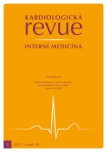Hypertension and heart failure
Authors:
M. Bláha
Authors‘ workplace:
II. interní klinika LF MU a FN U sv. Anny v Brně
Published in:
Kardiol Rev Int Med 2017, 19(2): 92-97
Overview
Hypertensive heart disease involves a broad spectrum of alterations of the left ventricle, including asymptomatic left ventricle hypertrophy (LVH, either concentric or eccentric pattern) and clinical heart failure (with either preserved or reduced left ventricle ejection fraction – HFpEF, HFrEF). There is a considerable interindividual variability in the progression from hypertension to LVH in both the magnitude of the increase in LV mass and its geometric pattern (ventricular dilatation or wall thickening). Some of these differences are likely attributable to differences in the pressure load (differences in the amount of load, time and speed of pressure growth), concomitant medical conditions, the underlying neurohumoral status and some genetic influences. The progression from concentric hypertrophy to dilated cardiac failure (HFrEF) in the absence of myocardial infarction may not be a common pathway. However, some hypertonic patients may progress directly to dilated cardiac failure without previous myocardial infarction or concentric hypertrophy. It has not been fully explained why some hypertensive subjects develop LV dilatation and others concentric LVH. The mechanisms for progression from asymptomatic concentric LVH to clinical HFpEF have only been unravelled in part. At present, this transition appears to be associated with progressive adverse remodelling of the extracellular matrix and increase in LV filling pressure. Treatment of hypertension in patients with HF must take into account the type of HF. In general, patients with hypertension and HFrEF should be treated, if possible, with an angiotensin-converting enzyme inhibitor (ACEI), alternatively angiotensin receptor antagonist, or angiotensin receptor-neprilysin inhibitor (ARNI), a beta-blocker, and a mineralocorticoid receptor antagonist (MRA). Diuretics are used to treat symptomatic hypervolemia (pulmonary and/or peripheral oedema) or to further reduce blood pressure, if needed, in hypervolemic patients. The optimal therapy of hypertension in patients with HFpEF (i.e. diastolic dysfunction) is not completely clear. Most antihypertensive agents can reduce LV mass and it seems that this is the right way to reduce the risk of heart failure.
Keywords:
hypertension – left ventricle hypertrophy – heart failure with preserved ejection fraction – heart failure with reduced ejection fraction
Sources
1. Felšöci M, Špinar J. Hypertenze a akutní srdeční selhání. In: Jiří Widimský jr. Arteriální hypertenze – současné klinické trendy XIV. Praha: Triton, 2016.
2. Drazner MH. The progression of hypertensive heart disease. Circulation 2011; 123(3): 327– 334. doi: 10.1161/ CIRCULATIONAHA.108.845792.
3. Hwang SJ, Melenovsky V, Borlaugh BA. Implications od coronary artery disease in heart failure with preserved ejection fraction. J Am Coll Cardiol 2014; 63 (25 Pt A): 2817– 2827. doi: 10.1016/ j.jacc.2014.03.034.
4. Redfield MM. Heart failure with preserved ejection fraction. N Engl J Med 2016; 375(19): 1868– 1877.
5. Ponikowski P, Voors AA, Anker SD et al. 2016 ESC Guidelines for the diagnosis and treatment of acute and chronic heart failure. The Task Force for the diag-nosis and treatment of acute and chronic heart failure of the European Society of Cardiology (ESC). Developed with the special contribution of the Heart Failure Association (HFA) of the ESC. Eur Heart J 2016; 37(27): 2129– 2200. doi: 10.1093/ eurheartj/ ehw128.
6. Cleland JG. Cardiac remodeling: what has changed over the past 10 years? Dialogues Cardiovasc Med 2015; 20: 85– 104.
7. Borlaugh BA, Lam CS, Roger VL et al. Contractility and ventricular systolic stiffening in hypertensive heart disease: insights into pathogenesis of heart failure with preserved ejection fraction. J Am Coll Cardiol 2009; 54(5): 410– 418. doi: 10.1016/ j.jacc.2009.05.013.
8. James PA, Oparil S, Carter BL et al. 2014 Evidence-based guideline for management of high blood pressure in adults: report from the panel members appointed to the Eighth Joint National Committee (JNC 8). JAMA 2014; 311(5): 507– 520. doi: 10.1001/ jama.2013.284427.
9. McMurray JJ, Packer M, Desai AS et al. PARADIGM-HF Investigators and Committees. Angiotensin-neprilysin inhibitor versus enalapril in heart failure. N Engl J Med 2014; 371(11): 993– 1004. doi: 10.1056/ NEJMoa1409077.
10. Hradec J. Sacubitril/ valsartan – nový duální inhibitor neprilysinu a receptorů pro angiotensin II. Remedia 2016; 26: 102– 108.
11. Wright JT, Williamson JD, Whelton PK et al. The SPRINT Research Group. A randomized trial of intensive versus standard blood-pressure control. N Engl J Med 2015; 373(22): 2103– 2116. doi: 10.1056/ NEJMoa1511939.
Labels
Paediatric cardiology Internal medicine Cardiac surgery CardiologyArticle was published in
Cardiology Review

2017 Issue 2
Most read in this issue
- Target blood pressure values in heart failure
- New fixed antihypertensive combinations
- Electrocardiogram and cardiac stimulation
- Pharmacotherapy of heart failure with preserved ejection fraction
